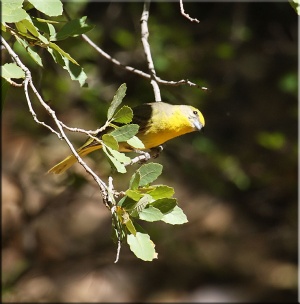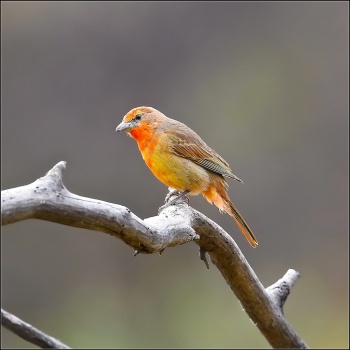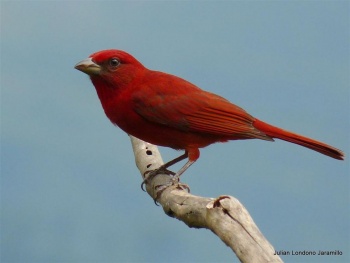m (→External Links: removed BFTV link) |
|||
| (26 intermediate revisions by 11 users not shown) | |||
| Line 1: | Line 1: | ||
| − | + | [[Image:Hepatic_Tanager_northern_by_peterday.jpg|thumb|550px|right|Male of Northern group<br />Photo © by {{user|peterday|peterday}}<br />Madera Canyon, [[Arizona]], [[USA]], July 2011]] | |
| − | + | ;[[:Category:Piranga|Piranga]] flava | |
| − | [[Image: | + | '''Includes: Tooth-billed Tanager; Red Tanager''' |
==Identification== | ==Identification== | ||
| − | + | [[Image:Female_Hepatic_Tanager_Huachuca_Canyon_May_30_2008_by_Lisa_W.jpg|thumb|300px|right|Female of Northern group<br />Photo © by {{user|Lisa+W|Lisa W}}<br />Huachuca Canyon, [[Arizona]], [[USA]], May 2008]] | |
| + | 18 cm (7 in) | ||
| + | |||
| + | *Male: dark red to orange-red, grey wash on back and flanks. Grey-red cheek patch. Heavy, slightly hooked, and dark bill. | ||
| + | *Female: olive-green upperparts and yellow-orange underparts with grey wash on flanks. | ||
| + | *Juvenile: paler underparts, brown streaks, and buff-gray wing-bars. <br /> | ||
| + | ====Variations==== | ||
| + | Males of the Highland Hepatic Tanager group have a two-toned bill, dark upper and yellow lower mandible; in Lowland Hepatic Tanager, the lower mandible is grey vs black for upper. The three forms also differ in the tone of the red in males, as seen in the images. | ||
==Distribution== | ==Distribution== | ||
| + | [[North America]], [[Central America]], and [[South America]]. <br /> | ||
| + | In the [[U.S.A]], summers in [[Arizona]] and [[New Mexico]]. These and populations in northern [[Mexico]] mostly migrate south to an area from southern Mexico to [[Guatemala]]. Populations breeding in Guatemala and [[Belize]] and south through Central and South America are resident. In western and northern South America, they primarily are found in highlands of [[Trinidad]], [[Venezuela]], The [[Guianas]], [[Colombia]], [[Ecuador]], [[Peru]], and [[Bolivia]]. A separate form is found mainly in lowlands of They Guianas, [[Brazil]], eastern [[Bolivia]], [[Paraguay]], north eastern [[Argentina]] and [[Uruguay]]. | ||
| + | ==Taxonomy== | ||
| + | [[Image:Hepatic TanagerJuvieSJ.jpg|thumb|350px|right|Juvenile<br />Photo © by {{user|Stanley+Jones|Stanley Jones}}<br />Córdoba Province, [[Argentina]], October, 2019]] | ||
| + | ====Subspecies==== | ||
| + | [[Image:Highland_Hepatic_Tanager_Male_by_aralcal.JPG|thumb|350px|right|Male of Highland group showing the typical two-toned bill<br />Photo © by {{user|Aralcal|Aralcal}}<br />Aralcal, [[Colombia]], January 2009]] | ||
| + | Several subspecies exist<sup>[[#References|[1]]]</sup>. These fall into three main groups that sometimes are considered separate species: The Northern Hepatic Tanager (''P. hepatica'' - first five subspecies in the list), the Highland Hepatic Tanager (''P. lutea'' - subspecies 6-11 in the list) and the Lowland Hepatic Tanager (''P. flava'' - last four subspecies):<br /> | ||
| + | '''Northern Group''' | ||
| + | *''P.f. hepatica'': South-western [[US]] and western [[Mexico]] (south to Guerrero and Oaxaca) | ||
| + | *''P.f. dextra'': South-western US (east of Rockies) and eastern Mexico; winters to western [[Guatemala]] | ||
| + | *''P.f. figlina'': Lowland pine savanna of eastern Guatemala and [[Belize]] | ||
| + | *''P.f. savannarum'': Lowland pine savanna of eastern [[Honduras]] and north-eastern [[Nicaragua]] | ||
| + | *''P.f. albifacies'': Montane oak-pine belt of western Guatemala to northern Nicaragua<br /> | ||
| + | '''Highland Group''' | ||
| + | *''P.f. testacea'': Subtropical [[Costa Rica]] and [[Panama]] (east to Cape Gararchiné) | ||
| + | *''P.f. desidiosa'': Upper tropical and subtropical south-western [[Colombia]] | ||
| + | *''P.f. lutea'': Extreme south-western Colombia to western [[Ecuador]], [[Peru]] and north-western [[Bolivia]] | ||
| + | *''P.f. haemalea'': Mountains of southern [[Venezuela]], western [[Guyana]] and extreme northern [[Brazil]] | ||
| + | *''P.f. faceta'': Mountains of northern [[Colombia]] and northern Venezuela; winters to [[Trinidad]] | ||
| + | *''P.f. toddi'': Western slope of Eastern Andes of Colombia (Magdalena)<br /> | ||
| + | '''Lowland Group''' | ||
| + | *''P.f. macconnelli'': Southern Guyana and adjacent extreme northern Brazil | ||
| + | *''P.f. saira'': Eastern Brazil (Amazon to Mato Grosso and Rio Grande do Sul) | ||
| + | *''P.f. rosacea'': Eastern Bolivia (Santa Cruz to Chiquitos) | ||
| + | *''P.f. flava'': Southern Bolivia (Cochabamba) to [[Uruguay]] and northern [[Argentina]] | ||
| − | |||
| − | |||
==Habitat== | ==Habitat== | ||
| − | + | Open pine and pine-oak forests, often near water. | |
| − | |||
==Behaviour== | ==Behaviour== | ||
| + | ====Diet==== | ||
| + | Their main diet consists of insects with the addition of fruits such as figs, ripe guavas, grapes and cherries. | ||
| + | ==Gallery== | ||
| + | Click on photo for larger image | ||
| + | <gallery> | ||
| + | Image:Lowland_Hepatic_Tanager_by_Rogerio_Araujo_Dias.jpg|Male of Lowland group showing paler red and also a two-toned bill<br />Photo © by [http://www.birdforum.net/gallery/member.php?uid=44584 Rogerio Araújo Dias]<br />Brasilia, [[Brazil]] | ||
| + | Image:Lowland_Hepatic_Tanager_by_jarbas_mattos.jpg|Female of Lowland group<br />Photo © by {{user|jarbas+mattos|jarbas mattos}}<br />Campos do Jordão, [[Brazil]] March 2011 | ||
| + | </gallery> | ||
| + | ==References== | ||
| + | #{{Ref-Clements6thAug19}}# Ber van Perlo. 2009. A field guide to the Birds of Brazil. Oxford University Press, New York, NY, USA. ISBN 978-0-19-530155-7 | ||
| + | # Kenefick, Restall, Hayes, 2007. Field guide to the birds of Trinidad and Tobago. Yale University Press. ISBN 978-0-300-13557-2 | ||
| + | # Howell & Webb, 1995. A guide to the birds of Mexico and northern Central America. Oxford University Press. ISBN 0198540124 | ||
| + | ==External Links== | ||
| + | {{GSearch|"Piranga flava" {{!}} "Hepatic Tanager" {{!}} "Tooth-billed Tanager" {{!}} "Red Tanager" -"Habia"}} | ||
| + | {{GS-checked}}1 | ||
| + | <br /> | ||
| + | <br /> | ||
| − | + | [[Category:Birds]] [[Category:Piranga]] | |
| − | |||
| − | |||
| − | |||
| − | |||
| − | |||
| − | |||
| − | |||
| − | [[Category: | ||
Latest revision as of 18:47, 4 June 2023
- Piranga flava
Includes: Tooth-billed Tanager; Red Tanager
Identification
18 cm (7 in)
- Male: dark red to orange-red, grey wash on back and flanks. Grey-red cheek patch. Heavy, slightly hooked, and dark bill.
- Female: olive-green upperparts and yellow-orange underparts with grey wash on flanks.
- Juvenile: paler underparts, brown streaks, and buff-gray wing-bars.
Variations
Males of the Highland Hepatic Tanager group have a two-toned bill, dark upper and yellow lower mandible; in Lowland Hepatic Tanager, the lower mandible is grey vs black for upper. The three forms also differ in the tone of the red in males, as seen in the images.
Distribution
North America, Central America, and South America.
In the U.S.A, summers in Arizona and New Mexico. These and populations in northern Mexico mostly migrate south to an area from southern Mexico to Guatemala. Populations breeding in Guatemala and Belize and south through Central and South America are resident. In western and northern South America, they primarily are found in highlands of Trinidad, Venezuela, The Guianas, Colombia, Ecuador, Peru, and Bolivia. A separate form is found mainly in lowlands of They Guianas, Brazil, eastern Bolivia, Paraguay, north eastern Argentina and Uruguay.
Taxonomy
Subspecies
Several subspecies exist[1]. These fall into three main groups that sometimes are considered separate species: The Northern Hepatic Tanager (P. hepatica - first five subspecies in the list), the Highland Hepatic Tanager (P. lutea - subspecies 6-11 in the list) and the Lowland Hepatic Tanager (P. flava - last four subspecies):
Northern Group
- P.f. hepatica: South-western US and western Mexico (south to Guerrero and Oaxaca)
- P.f. dextra: South-western US (east of Rockies) and eastern Mexico; winters to western Guatemala
- P.f. figlina: Lowland pine savanna of eastern Guatemala and Belize
- P.f. savannarum: Lowland pine savanna of eastern Honduras and north-eastern Nicaragua
- P.f. albifacies: Montane oak-pine belt of western Guatemala to northern Nicaragua
Highland Group
- P.f. testacea: Subtropical Costa Rica and Panama (east to Cape Gararchiné)
- P.f. desidiosa: Upper tropical and subtropical south-western Colombia
- P.f. lutea: Extreme south-western Colombia to western Ecuador, Peru and north-western Bolivia
- P.f. haemalea: Mountains of southern Venezuela, western Guyana and extreme northern Brazil
- P.f. faceta: Mountains of northern Colombia and northern Venezuela; winters to Trinidad
- P.f. toddi: Western slope of Eastern Andes of Colombia (Magdalena)
Lowland Group
- P.f. macconnelli: Southern Guyana and adjacent extreme northern Brazil
- P.f. saira: Eastern Brazil (Amazon to Mato Grosso and Rio Grande do Sul)
- P.f. rosacea: Eastern Bolivia (Santa Cruz to Chiquitos)
- P.f. flava: Southern Bolivia (Cochabamba) to Uruguay and northern Argentina
Habitat
Open pine and pine-oak forests, often near water.
Behaviour
Diet
Their main diet consists of insects with the addition of fruits such as figs, ripe guavas, grapes and cherries.
Gallery
Click on photo for larger image
Male of Lowland group showing paler red and also a two-toned bill
Photo © by Rogerio Araújo Dias
Brasilia, BrazilFemale of Lowland group
Photo © by jarbas mattos
Campos do Jordão, Brazil March 2011
References
- Clements, J. F., T. S. Schulenberg, M. J. Iliff, S. M. Billerman, T. A. Fredericks, B. L. Sullivan, and C. L. Wood. 2019. The eBird/Clements Checklist of Birds of the World: v2019. Downloaded from http://www.birds.cornell.edu/clementschecklist/download/
- Ber van Perlo. 2009. A field guide to the Birds of Brazil. Oxford University Press, New York, NY, USA. ISBN 978-0-19-530155-7
- Kenefick, Restall, Hayes, 2007. Field guide to the birds of Trinidad and Tobago. Yale University Press. ISBN 978-0-300-13557-2
- Howell & Webb, 1995. A guide to the birds of Mexico and northern Central America. Oxford University Press. ISBN 0198540124
External Links
GSearch checked for 2020 platform.1









